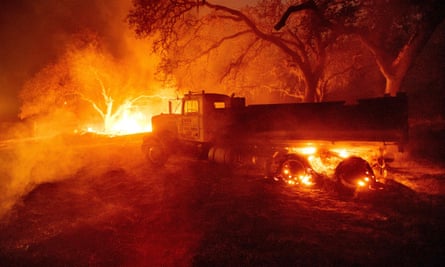Extract from The Guardian
Excessive heat warnings will remain in effect on the coast as the state closes in on a new record of 4m acres burned.

Last modified on Sat 3 Oct 2020 10.34 AEST
Smoke from nearly two dozen wildfires burning across California will continue to darken skies across the west this weekend, as residents prepare for more heat, toxic air and conditions that are expected to keep fueling the flames.
The National Weather Service reports that both excessive heat warnings and heat advisories will remain in effect along California’s coast, while the Bay Area Air Quality Management District has extended its Spare the Air Alert through Tuesday, with air quality deemed “unhealthy”. Meanwhile the state is closing in on a devastating new record, with close to 4m acres now consumed by wildfires this season.
“It’s likely that over the next day or two we will crest the 4m-acre mark. The biggest year before this year was 1.54m,” said Thom Porter, a chief with the California Department of Forestry and Fire Protection, or Cal Fire. “We are dwarfing that previous record and we have a lot of season left to go.”
The grey smoky haze coating much of the west – from Portland, Oregon, to Santa Barbara, California, has created hazardous conditions that public health officials are concerned will have an impact even after the smoke clears. Researchers at Stanford University attributed roughly up to 3,000 additional deaths in California to just one month of the wildfire smoke, especially for at-risk or elderly people.
Dr Gina Solomon, a principle investigator for the Public Health Institute in San Francisco, says chronic exposure to the unsafe conditions takes a toll on lung capacity – and can have long term consequences.
“Not only is this happening year after year, but it is happening week after week and month after month, for a significant portion of the year. What this means is it is more likely there will be long-term effects on people’s health,” she says. For children, that means their lung function may fail to increase each year, as it should, and adults will see declining lung capacity at a steeper slope.
“We might have made it to age 80 feeling good and not getting short of breath when climbing a hill – now we may only make it to age 75,” she says. “It is insidious, it is subtle – but it is very worrisome.”
There have already been roughly 8,200 wildfires this year, according to state officials, and they left devastation in their wake. Since August, 31 people have been killed in the fires and nearly 8,000 structures have been destroyed. Roughly 53,000 people across California are currently evacuated.
Officials were prepared for dangerous conditions last weekend but couldn’t stop the spread of two new big blazes: the Glass fire in Sonoma and Napa counties and the Zogg fire in Shasta county, which both erupted Sunday. Collectively, they have consumed more than 116,100 acres, and by Friday were 6% and 46% contained, respectively.
Crews battling the Glass fire, burning through the wine country north of San Francisco, are on high alert as forecasters warn of red flag conditions of extreme fire danger into Saturday morning. Winds up to 30 mph (48 kph) were forecast to push through the hills of Napa and Sonoma counties as the fire threatens more than 28,000 homes and other buildings.
“It’s going to be a big firefight for us over the next 36 hours,” said Billy See, an assistant chief with Cal Fire.
California’s governor, Gavin Newsom, toured fire-ravaged Napa county on Thursday and said the state was putting “all we have in terms of resources” into firefighting, particularly over the 36 hours of the windy period.
The Glass fire is the fourth major blaze in the region in three years and comes ahead of the third anniversary of 2017 wildfire that killed 22 people.
Newsom said people there have been “torn asunder by wildfires seemingly every single year, this drumbeat, where people are exhausted, concerned, anxious about their fate and their future.”
Numerous studies have linked bigger wildfires in America to the climate crisis. Rising temperatures in the west have created drier conditions that, combined with poor vegetation-management policies and human encroachment into fire-prone areas, driven by the state’s housing crisis, have led to the annual disasters. Scientists predict the worst of this record-breaking season may still be yet to come.
“Our fire season is by no means over,” Alex Hall, the director of the Center for Climate Science at UCLA, told the Guardian, explaining that California is only now entering the part of the season where the dry winds pick up.
Hall is hopeful that the attention on California’s disasters will galvanize a stronger response to the climate crisis.
“Climate change is happening now”, he says. “We have to fix our relationship with our forests. We have to fix our relationship with our natural landscapes. The urgency of that is underscored by this human catastrophe – and it is obvious that time is up.”
No comments:
Post a Comment